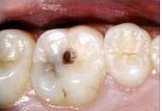
a. Photo

b. Description (gram stain)
The lactobacillus acidophilus is in either a chained
cocci, or rod shaped form. They test gram positive. They are both nonmotile,
and nosporulating bacteria. They also produce lactic acid.
c. (Organisms mode of operation how the organism attacks and spreads)
The bacteria combine with proteins that are found
in saliva and food debris, forming plaque. The plaque then goes about digesting
sugary and other easily digestible foods. After they have finished eating,
they excrete an acid. If there is enough bacteria excreting acid in one
area, then the calcium can get dissolved. Not only do acid attacks dissolve
calcium, but it also removes some tooth enamel. Once enough tooth enamel
is removed, there is a groove. In this shallow hole, the lactobacillus
acidophilus positions itself on the groove, and begins the process of tooth
decay.
d. Most common victims to prey upon
Cavities are usually found in children and young
people. This does not mean that adults will not get cavities, but they
are at a lesser risk of getting cavities.
e. Where it is most likely to be found
The lactobacillus acidophilus is usually found in
the cavitated area of a tooth. This is because the lactobacillus acidophilus
is not very adhesive. However, once it becomes situated in the hole, it
speeds up the decaying process.
f. Most common injury done to victim
The acidophilus cavities are major promoters in
causing tooth decay. The decay causes caries or cavities in the tooth,
and the open space has to be filled up with a metallic mixture.
g. Rate the degree of damage caused
Cavities can cause a great amount of damage to a
tooth. If one is left untreated, the lactobacillus acidophilus will enlarge
inside the internal structures of the tooth. This can then lead to death
in the nerve and blood vessels in the tooth.
h. Number of victims
Today, in the United States, 54 million, or 26 %
of children aged two to seventeen have no cavities in their permanent teeth.
In baby teeth, 60% of children under ten had no cavities. This is good,
because throughout the years 1971-1974, the percentage of children in the
same age group had more than double the amount of cavities. Next to the
common cold, cavities are the second most common of disorders occurring
in people.
i. Most effective weapons against the germ
Saliva is rather basic, and it dilutes the acid
poured out from the acid attacks. However, saliva only works when one is
awake, for when asleep, no more saliva is produced. Taking care of one's
teeth is also an effective weapon for fighting cavities. A recommendation
to prevent the plaque from excreting acid at sleep-time is by brushing
(dislodging plaque) before they can attack. Frequent snacking causes one's
mouth to be continually filled with acid, so minimizing snacking habits
is a good tool to have. Dental sealants are also good. Sealants are a type
of coating, which is applied to one's molars. Such armor will protect vulnerable
surfaces from getting enough plaque to cause cavities. Another effective
tool is that of fluoride. Fluoride works best when it is ingested when
the teeth are yet developing. The fluoride then mixes with the enamel and
protects it against some acids.
Another way to use fluoride is to drink it in ones water, or having
fluoride supplements. Dental visits are also an effective way to fight
cavities.

Bibliography:
http://www.howstuffworks.com/cavity.htm
http://www.bact.wisc.edu/ScienceEd/lactobacillusacidophilus.html
http://www4.parentsplace.com/expert/dentist/otherissues/qa/0%2C3459%2C11740%2C00.html
http://health.yahoo.com/health/Diseases_and_Conditions/Disease_Feed_Data/Dental_caries/
http://www.parentsplace.com/expert/dentist/oralhealth/qa/0%2C3459%2C7011%2C00.html
Return
to Bacterial Disease Page